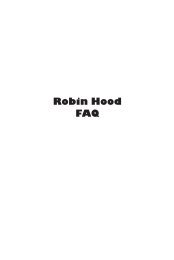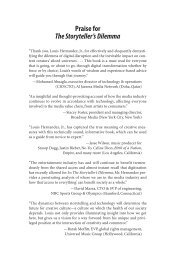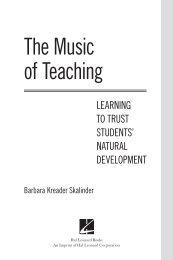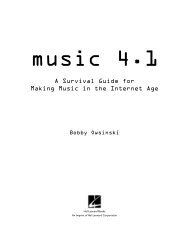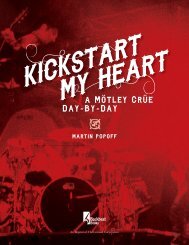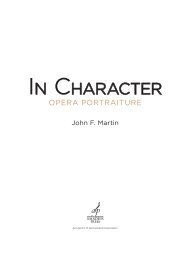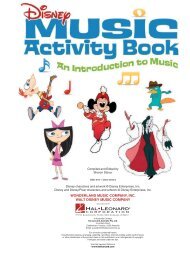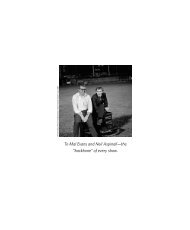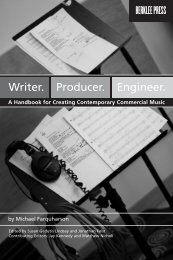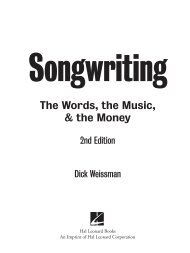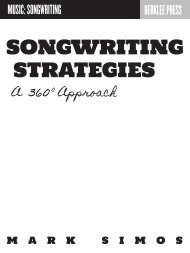Art Song - Linking Poetry and Music
Create successful ePaper yourself
Turn your PDF publications into a flip-book with our unique Google optimized e-Paper software.
ISBN 978-1-6177-4080-0<br />
Copyright © 2013 by Carol Kimball<br />
All rights reserved. No part of this book may be reproduced in any form or by any electronic or<br />
mechanical means including information storage <strong>and</strong> retrieval systems without permission in<br />
writing from the publisher, except by a reviewer, who may quote brief passages in a review.<br />
Hal Leonard Corporation<br />
7777 W. Bluemound Rd.<br />
P.O. Box 13819<br />
Milwaukee, WI 53213<br />
Library of Congress Cataloging-in-Publication Data<br />
Kimball, Carol (Mezzo-soprano)<br />
<strong>Art</strong> song : linking poetry <strong>and</strong> music / Carol Kimball.<br />
pages cm<br />
ISBN 978-1-61774-080-0<br />
1. <strong>Song</strong>s--Analysis, appreciation. 2. <strong>Song</strong>s--Interpretation (Phrasing,<br />
dynamics, etc.) 3. <strong>Song</strong>s--History <strong>and</strong> criticism. I. Title.<br />
MT120.K55 2013<br />
782.42168--dc23<br />
2013014322<br />
Printed in the U.S.A.<br />
Visit Hal Leonard Online at www.halleonard.com
Contents<br />
Foreword 9<br />
Acknowledgements 13<br />
1 What is <strong>Art</strong> <strong>Song</strong>? 15<br />
<strong>Art</strong> <strong>Song</strong>: A Unique Hybrid 15<br />
<strong>Art</strong> <strong>Song</strong> <strong>and</strong> Popular <strong>Song</strong> 16<br />
Why Sing <strong>Art</strong> <strong>Song</strong>s? 17<br />
<strong>Poetry</strong> as the Basis for <strong>Art</strong> <strong>Song</strong> 18<br />
Creating a <strong>Music</strong>al Framework for Poems 19<br />
Composers: On finding the right poem 19<br />
Working With <strong>Art</strong> <strong>Song</strong>: The Singer’s Task 22<br />
A Roadmap for Working With an <strong>Art</strong> <strong>Song</strong> 23<br />
2 <strong>Poetry</strong> Basics for Singers 27<br />
What Is <strong>Poetry</strong>?27<br />
Who’s Afraid of <strong>Poetry</strong>? 28<br />
The Power of Language29<br />
Perks from <strong>Poetry</strong>30<br />
Beginning to Look at Poems31<br />
Guidelines for Beginning Readers of <strong>Poetry</strong> 32<br />
Things to Notice:33<br />
How does it look? 33<br />
An Unusual Poetic Form 33<br />
Important Basics35<br />
Word Sounds 36<br />
Texture 37<br />
Imagery 37<br />
Rhythm <strong>and</strong> Rhyme 40<br />
Noticing Dramatic Qualities42<br />
Reading <strong>Poetry</strong>—Pleasure Through Sound42<br />
Reading <strong>Poetry</strong>—Pleasure Through Association43<br />
Hearing Poems—Pleasure Through Listening43<br />
Reading <strong>and</strong> Memorizing Poems44
Some Helpful Resources44<br />
Websites to Visit 44<br />
<strong>Poetry</strong> Books w/Recordings or Videos (Selected) 45<br />
Some Foreign Language Resources for<br />
Listening to <strong>Poetry</strong> 46<br />
Applications for Electronic Devices 47<br />
Selected Bibliography for this Chapter 47<br />
3 Working With <strong>Poetry</strong> 51<br />
Making <strong>Poetry</strong> a Part of Your Preparation 51<br />
The Sounds of Words 52<br />
Speak the Speech, I Pray You… 53<br />
Reading Poems Aloud 53<br />
Working With Foreign Language Texts 55<br />
Exercises for Working With Texts 57<br />
Descriptors 57<br />
Five American Poems for Defining Descriptors 58<br />
Five British Poems for Defining Descriptors 60<br />
Five German Poems for Defining Descriptors 63<br />
Five French Poems for Defining Descriptors 67<br />
Five Italian Poems for Defining Descriptors 71<br />
Five Spanish Poems for Defining Descriptors 73<br />
Getting in Touch With Your Speaking Voice 76<br />
Texture = Sound Quality 76<br />
Be a <strong>Poetry</strong> Detective 81<br />
Reciting to <strong>Music</strong> 82<br />
Take the <strong>Poetry</strong> Pledge: Read a Poem a Day 83<br />
Recommended American <strong>Poetry</strong> for Reading Aloud 84<br />
Recommended British <strong>Poetry</strong> for Reading Aloud 87<br />
Reading <strong>Poetry</strong> in Foreign Languages 89<br />
Recommended German <strong>Poetry</strong> for Reading Aloud 90<br />
Recommended French <strong>Poetry</strong> for Reading Aloud 91<br />
Recommended Italian <strong>Poetry</strong> for Reading Aloud 92<br />
Recommended Spanish <strong>Poetry</strong> for Reading Aloud 94<br />
A Selected List of Helpful Poetic Terms 95
4 Working With <strong>Music</strong> 105<br />
The <strong>Music</strong>al Framework for the Poem 105<br />
The “Why” of the <strong>Music</strong>al Setting 106<br />
Setting Words to <strong>Music</strong> 107<br />
When Composer <strong>and</strong> Poet Collaborate 109<br />
The <strong>Music</strong> of <strong>Art</strong> <strong>Song</strong>: A Vocabulary List 111<br />
Style in <strong>Art</strong> <strong>Song</strong> 113<br />
Components of Style 114<br />
Melody 114<br />
Harmony 115<br />
Rhythm 117<br />
The Piano in <strong>Art</strong> <strong>Song</strong> 119<br />
Form 121<br />
Exercise: An Examination of Three <strong>Music</strong>al Settings 121<br />
Cultural/<strong>Art</strong>istic Contexts for Studying <strong>Art</strong> <strong>Song</strong>s 122<br />
<strong>Art</strong> <strong>Song</strong> Study Sheets 125<br />
Charles Ives: The Circus B<strong>and</strong> 125<br />
Dominick Argento: Winter 128<br />
Aaron Copl<strong>and</strong>: Heart, we will forget him 131<br />
Samuel Barber: A Nun Takes the Veil (Heaven-Haven) 133<br />
5 Working With Repertoire: Formatting Recitals 139<br />
The Recital Template: Building Programs 139<br />
Creating a Cohesive Program 139<br />
Some Parameters <strong>and</strong> Guidelines 141<br />
Variety Is the Spice of Life 144<br />
Encore! 144<br />
Choosing Repertoire 146<br />
Be a Pro-active Planner 146<br />
Wise Choices for Your Voice 147<br />
A Caveat for Recital Planners 148<br />
A Word on Gender-Specific Texts 148<br />
A Word on Transpositions 150<br />
Arias on Recitals? 150<br />
Repertoire Checklist 151<br />
Creating <strong>Song</strong> Groups 151<br />
Opening Groups 153<br />
Opening Groups in Italian, English, Spanish 153<br />
Examples of Weaker Groups 154
<strong>Song</strong> Choices for Different Occasions 155<br />
Ramping Up the <strong>Song</strong> Recital: Thinking Outside the Box 158<br />
Making Imaginative Choices 158<br />
<strong>Song</strong> Groups with Different Designs 159<br />
Shakespeare 159<br />
One-poet Groups 159<br />
Groups that Feature One Character/<br />
Linked Characters 162<br />
Adding Instruments to the Mix 163<br />
Selected List of Vocal Works With Instruments 163<br />
Women Poets/Women Composers 166<br />
More Design Topics on the Subject of Women 168<br />
Theme Recitals 171<br />
Crossovers in the Concert Hall 173<br />
What do you want the audience to remember? 175<br />
Adding props, costumes, or staging to the art song 176<br />
6 The Performance of <strong>Art</strong> <strong>Song</strong> 179<br />
The <strong>Art</strong>istic Quest 180<br />
What Do You Put First? Yourself or the <strong>Music</strong>? 180<br />
The Singer as a Conduit 181<br />
The Final Goal: An Organic Performance 183<br />
Interpretation <strong>and</strong> Individuality 184<br />
Imagination <strong>and</strong> Creativity 185<br />
Shaping Phrases Creatively 187<br />
Performance Is a Collaborative Effort 187<br />
The Singer-Pianist Duo 188<br />
Working With the Composer 189<br />
Matters of Style 191<br />
The <strong>Art</strong> <strong>Song</strong> Recital: <strong>Art</strong> or Entertainment? 192<br />
How Much Is Too Much?—Thoughts on Dramatization 193<br />
Le bon gout? 193<br />
Example: Ravel’s Histoires naturelles 194<br />
Are You a Good Storyteller? 196<br />
Some Thoughts on Interpretation 198<br />
Some Models of <strong>Art</strong>istry in Recital Performance 201<br />
Envoi… 204
7 A Selected List of Vocal Literature for<br />
Collegiate Voice Majors (Undergraduate) 207<br />
Building an <strong>Art</strong> <strong>Song</strong> Library 207<br />
Criteria for Choices 208<br />
American <strong>Art</strong> <strong>Song</strong> 209<br />
German Lieder 223<br />
French Mélodie 237<br />
British <strong>Art</strong> <strong>Song</strong> 246<br />
Italian <strong>Art</strong> <strong>Song</strong> 253<br />
Spanish <strong>and</strong> South American <strong>Art</strong> <strong>Song</strong> 257<br />
Crossover Repertoire 262<br />
Choosing Literature 263<br />
Afterword 269<br />
Appendix 1: The <strong>Poetry</strong> Poll 271<br />
Appendix 2: The Printed Program: Guidelines 289<br />
General Format: The Look of the Program 289<br />
Cover Page, Program Page, Program Notes 290<br />
A Word About Fonts 291<br />
What to Leave Out 295<br />
Sundry Slip-Ups 296<br />
Setting the Tone: Program Notes 299<br />
Paraphrasing 300<br />
Translations 303<br />
Credit Where Credit is Due 304<br />
Are Any of These Yours? 304<br />
Proofread Your Program! 306<br />
A Proofreader’s Quiz 306<br />
Guidelines for <strong>Song</strong> Titles 306<br />
Guidelines for Printed Material: Suggested Reading 308<br />
Appendix 3: A Selection of Various Recital Programs 311<br />
Some Junior Voice Recitals 311<br />
Some Senior Voice Recitals 316<br />
Some Masters Voice Recitals 323<br />
Some Doctoral Voice Recitals 331<br />
A Theme Recital 340
A One-Language Theme Recital 342<br />
A Doctoral Recital Contrasting Two Cycles 344<br />
A <strong>Music</strong>al Theatre Program in “Recital” Format 346<br />
Dame Janet Baker: An <strong>Art</strong>ist Recital 349<br />
Dietrich Fischer-Dieskau: A One-Poet Recital 350<br />
Joy in Singing Award Recital 352<br />
Victoria de Los Angeles: An All-Spanish Recital 356<br />
Poulenc: Le Travail du peintre<br />
(notes for a Multi-Media Recital) 357<br />
<strong>Poetry</strong> Permissions 361<br />
A Selected Bibliography 369<br />
General Studies of <strong>Song</strong> Repertoire <strong>and</strong> History 369<br />
Poetic Studies <strong>and</strong> Translations 373<br />
Performance Preparation 381<br />
Diction 383<br />
Repertoire Studies <strong>and</strong> Style 385<br />
German Lieder 385<br />
French Mélodie 387<br />
American <strong>Art</strong> <strong>Song</strong> 391<br />
British <strong>Art</strong> <strong>Song</strong> 392<br />
Italian <strong>Art</strong> <strong>Song</strong> 393<br />
Spanish <strong>Art</strong> <strong>Song</strong> 394<br />
South American <strong>Art</strong> <strong>Song</strong> 394<br />
About the Author 397
Chapter 3: Working With <strong>Poetry</strong><br />
Take the <strong>Poetry</strong> Pledge: Read a Poem a Day<br />
<strong>Poetry</strong> is a river; many voices travel in it; poem after poem<br />
moves along in the exciting crests <strong>and</strong> falls of the river waves. 12<br />
—Mary Oliver<br />
Below is a list of poems that can serve as practice material for<br />
reading poetry aloud. These were chosen because all of them have<br />
been set as art songs. Many of these can be found in poem anthologies,<br />
others may be accessed by individual poet in library catalogs or on the<br />
Internet. As a beginning goal, pick a poem every day or so for your<br />
“reading practice.” It will be easiest to begin with poetry by American<br />
or British poets <strong>and</strong> then move on to foreign language texts. Take the<br />
poetry pledge: try to work your way up to reading a poem every day.<br />
As daily reading becomes a habit, you will soon identify poets whose<br />
work you enjoy reading, who are “on the same wave length.” Perhaps<br />
you will be drawn to a specific historical period <strong>and</strong> a group of poets,<br />
or one specific poet who wrote at that time. These discoveries are useful<br />
in building recital groups <strong>and</strong>/or programs.<br />
Reading a poem daily becomes a habit that yields excellent results<br />
in our study of songs. If singers took the time to read poems aloud<br />
each day, just as they schedule time in the practice room to warm<br />
up their voices, <strong>and</strong> to learn <strong>and</strong> practice their music, imagine what<br />
cumulative dividends it would pay in terms of their performances.<br />
Choose any poem to begin your work. Do not feel you have to<br />
complete the entire list. Do not be in a hurry to move on to another<br />
poem until you are satisfied that you have done a thorough job with<br />
the poem you are working with <strong>and</strong> have mastered reading it aloud.<br />
As you work, it might be useful to record yourself; it might also be<br />
valuable to read aloud for another person (perhaps another singer also<br />
engaged in reading poetry aloud) so that you can gather constructive<br />
comments on your reading.<br />
Although many of these poems have been set by several composers<br />
(some are listed in parentheses after the poem’s title), this list is for<br />
practice reading the poems aloud, <strong>and</strong> this goal should be accomplished<br />
apart from any musical setting. Copy the poem apart from the musical<br />
score or read it from a poetry anthology. Do not use the musi-<br />
83
<strong>Art</strong> <strong>Song</strong>: <strong>Linking</strong> <strong>Poetry</strong> <strong>and</strong> <strong>Music</strong><br />
cal score for your reading practice! Remember, you are reading aloud<br />
for fluency <strong>and</strong> for pleasure. Derek Attridge advises in his book Poetic<br />
Rhythm: “When possible, read aloud. Even when you read a poem<br />
silently, it should take up the same amount of time reading aloud<br />
would give it.” 13<br />
A list of books to help further your goals of reading poetry may be<br />
found in the Bibliography at the back of the book (see “<strong>Poetry</strong>: References<br />
for Study”). An abridged glossary of helpful poetic terms can be<br />
found at the conclusion of this chapter.<br />
Recommended American <strong>Poetry</strong> for Reading Aloud<br />
Henry Wadsworth Longfellow (1807–1882)<br />
The Children’s Hour<br />
(Charles Ives)<br />
Walt Whitman (1819–1892)<br />
Beginning my studies<br />
To what you said<br />
Emily Dickinson (1830–1886)<br />
Dear March, come in!<br />
Wild nights! Wild nights!<br />
It’s all I have to bring today<br />
Will there really be a morning?<br />
There came a wind like a bugle<br />
I’m Nobody! Who are you?<br />
Heart! we will forget him<br />
Ample make this Bed—<br />
Robert Frost (1874–1963)<br />
The Rose Family<br />
Stopping by the Woods on a<br />
Snowy Evening<br />
The Pasture<br />
(Lee Hoiby)<br />
(Leonard Bernstein [<strong>Song</strong>fest])<br />
(Aaron Copl<strong>and</strong>, Lori Laitman)<br />
(Ernst Bacon, Lee Hoiby, Lori Laitman,<br />
Richard Pearson Thomas)<br />
(Ernst Bacon, Lori Laitman)<br />
(Ernst Bacon, Ricky Ian Gordon,<br />
Richard Hundley, Vincent Persichetti,<br />
André Previn, Lori Laitman)<br />
(Aaron Copl<strong>and</strong>, Ernst Bacon<br />
[titled “A wind like a bugle”],<br />
Lee Hoiby, Thomas Pasatieri)<br />
(Lori Laitman, <strong>Art</strong>hur Farwell,<br />
Vincent Persichetti, Ernst Bacon)<br />
(John Duke, <strong>Art</strong>hur Farwell,<br />
Aaron Copl<strong>and</strong>, Richard Hundley)<br />
(Daron Hagen, Jake Heggie,<br />
<strong>Art</strong>hur Farwell, Gerald Ginsburg)<br />
(John Musto, Elliott Carter)<br />
(Ned Rorem)<br />
(Charles Naginski, Henry Cowell)<br />
84
Chapter 3: Working With <strong>Poetry</strong><br />
Carl S<strong>and</strong>burg (1878–1967)<br />
Omaha<br />
Fog<br />
James Joyce (1882–1941)<br />
In the dark pine-wood<br />
I hear an army charging<br />
upon the l<strong>and</strong><br />
Strings in the earth <strong>and</strong> air<br />
Sara Teasdale (1884–1933)<br />
The Metropolitan Tower<br />
The Mystery<br />
Elinor Wylie (1885–1928)<br />
Let us walk in the white snow<br />
Little Elegy<br />
(Ernst Bacon)<br />
(Roy Harris, Alan Hovhaness)<br />
(Samuel Barber, Ben Moore)<br />
(Samuel Barber, David Del Tredici<br />
[titled “I hear an army”])<br />
(Richard Hundley, Luciano Berio,<br />
Jean Coulthard)<br />
(Lori Laitman)<br />
(Lori Laitman)<br />
(R<strong>and</strong>all Thompson<br />
[titled “Velvet Shoes”], Mary Howe,<br />
John Duke, Richard Hageman)<br />
(Lori Laitman, John Duke,<br />
Mary Howe, Ned Rorem)<br />
Edna St. Vincent Millay (1892–1950)<br />
Recuerdo<br />
(John Musto,<br />
Mario Castelnuovo-Tedesco)<br />
Afternoon on a Hill<br />
(<strong>Art</strong>hur Farwell)<br />
Pity me not because the light of day (William Bolcom)<br />
Sonnet XLIII: What lips my lips (Jake Heggie, Leonard Bernstein,<br />
have kissed, <strong>and</strong> where, <strong>and</strong> why Jack Beeson)<br />
e. e. (Edward Estlin) cummings (1894–1962)<br />
meggie <strong>and</strong> milly <strong>and</strong> molly <strong>and</strong> may (Richard Hundley, John Musto,<br />
Vincent Persichetti)<br />
i carry your heart with me… (John Duke<br />
[titled “i carry your heart”])<br />
who knows if the moon’s a balloon (Dominick Argento,<br />
Vincent Persichetti, Lee Hoiby<br />
[titled “always, it’s spring”])<br />
when faces called flowers<br />
(Dominick Argento, John Duke)<br />
float out of the ground<br />
Robert Hillyer (1895–1961)<br />
Early in the Morning<br />
(Ned Rorem, John Duke<br />
[titled “Morning in Paris”])<br />
85
<strong>Art</strong> <strong>Song</strong>: <strong>Linking</strong> <strong>Poetry</strong> <strong>and</strong> <strong>Music</strong><br />
(James Mercer) Langston Hughes (1902–1967)<br />
<strong>Song</strong> for a Dark Girl<br />
(Ricky Ian Gordon)<br />
Genius Child<br />
(Ricky Ian Gordon)<br />
Dream Variations<br />
(Margaret Bonds)<br />
The Dream Keeper<br />
Theodore Roethke (1908–1963)<br />
The Waking<br />
(Ned Rorem, William Bolcom,<br />
Judith Cloud)<br />
My Papa’s Waltz<br />
(Ned Rorem, David Diamond)<br />
Elizabeth Bishop (1911–1979)<br />
Sonnet (I am in need of music)<br />
We lived in a pocket of time<br />
(Ben Moore, Chris DiBlasio,<br />
Judith Cloud, Tobias Picker,<br />
Lori Laitman [set as a duet])<br />
(Lee Hoiby [titled “A pocket of time”])<br />
Paul Goodman (1911–1972)<br />
The Lordly Hudson<br />
Such beauty as hurts to behold<br />
(Ned Rorem)<br />
(Ned Rorem)<br />
Tennessee Williams (1911–1983)<br />
The Cabin<br />
(Paul Bowles)<br />
Heavenly Grass<br />
(Paul Bowles)<br />
Three<br />
(Paul Bowles)<br />
Richard Wilbur (b.1921)<br />
Museum Piece<br />
For C<br />
It must be me<br />
Mary Oliver (b.1935)<br />
Last Night the Rain Spoke to Me<br />
Blue Iris<br />
Dana Gioia (b. 1950)<br />
The Apple Orchard<br />
Pentecost<br />
House (Insomnia No. 2)<br />
(Stephen Paulus)<br />
(Lori Laitman<br />
[titled “A Wild Sostenuto”])<br />
(Leonard Bernstein [C<strong>and</strong>ide])<br />
(Lori Laitman)<br />
(Lori Laitman)<br />
(Lori Laitman)<br />
(Lori Laitman)<br />
(Tom Cipullo)<br />
86
Chapter 3: Working With <strong>Poetry</strong><br />
Recommended British <strong>Poetry</strong> for Reading Aloud<br />
William Shakespeare (1564–1616)<br />
When icicles hang by the wall (Dominick Argento)<br />
O mistress mine<br />
It was a lover <strong>and</strong> his lass<br />
Fear no more the heat o’ the sun<br />
Come away, come away death<br />
(Gerald Finzi, Roger Quilter)<br />
(Peter Warlock [titled “Pretty ring<br />
time”], Erich Korngold [titled “When<br />
birds do sing”], Madeleine Dring,<br />
Gerald Finzi)<br />
(Gerald Finzi, Roger Quilter)<br />
(Ralph Vaughan Williams,<br />
Erich Korngold, Gerald Finzi<br />
[titled “Come away, death”],<br />
Dominick Argento [titled “Dirge”],<br />
Jacques Leguerney [titled “Come<br />
away, come away”], Lee Hoiby,<br />
Madeleine Dring, Roger Quilter)<br />
Ben Jonson (1572–1637)<br />
To Celia (Drink to me only<br />
with thine eyes)<br />
(Richard Faith, Roger Quilter)<br />
Orl<strong>and</strong>o Gibbons (1583–1625)<br />
The Silver Swan<br />
(Lori Laitman, Ned Rorem,<br />
Eric Thiman)<br />
Robert Herrick (1591–1674)<br />
Whenas in silks my Julia goes<br />
To the virgins,<br />
to make much of time<br />
To <strong>Music</strong>, to becalm his Fever<br />
Edmund Waller (1606–1687)<br />
<strong>Song</strong><br />
(Ned Rorem, John Corgliano<br />
[titled “Upon Julia’s Clothes”])<br />
(Madeleine Dring, Ben Moore,<br />
Mervyn Horder, Thomas Pasatieri:<br />
[titled “Gather ye rosebuds”], Roger<br />
Quilter [titled “To the virgins”])<br />
(Ned Rorem, Paul Hindemith)<br />
(Roger Quilter, Ned Rorem,<br />
[both titled “Go lovely rose”])<br />
Percy Bysshe Shelley (1792–1822)<br />
<strong>Music</strong>, when soft voices die<br />
(Richard Faith, Ernest Gold,<br />
David Diamond, Peter Warlock,<br />
Roger Quilter, Libby Larsen,<br />
Frank Bridge)<br />
87
<strong>Art</strong> <strong>Song</strong>: <strong>Linking</strong> <strong>Poetry</strong> <strong>and</strong> <strong>Music</strong><br />
John Keats (1795–1821)<br />
A Thing of Beauty<br />
(William Schuman [titled “Beauty”],<br />
Mario Castelnuovo-Tedesco)<br />
Robert Browning (1812–1889)<br />
Grow old along with me!<br />
(Lori Laitman<br />
[titled “Along with me”], Jake Heggie)<br />
The year’s at the spring<br />
(Amy Beach, Ned Rorem<br />
[titled “Pippa’s <strong>Song</strong>”])<br />
Christina Rossetti (1830–1894)<br />
Echo<br />
(Lori Laitman, John Musto,<br />
Richard Faith, Thomas Pasatieri)<br />
When I am dead, my dearest (Ralph Vaughan Williams,<br />
Richard Hageman, Lori Laitman<br />
[titled “<strong>Song</strong>”], Roger Quilter<br />
[titled “A song at parting”])<br />
My heart is like a singing bird (Ned Rorem, Mario Castelnuovo-<br />
Tedesco, Richard Faith)<br />
Lewis Carroll (1832–1898)<br />
Jabberwocky<br />
(Lee Hoiby, John Duke)<br />
Robert Louis Stevenson (1850–1894)<br />
I will make you brooches… (Ralph Vaughan Williams<br />
[titled “The Roadside Fire”])<br />
Bright is the Ring of Words<br />
(Ralph Vaughan Williams)<br />
The Vagabond<br />
(Ralph Vaughan Williams)<br />
A.E. Housman (1859–1936)<br />
Loveliest of trees<br />
When I was one-<strong>and</strong>-twenty<br />
The Half-Moon Westers Low<br />
(John Duke, George Butterworth,<br />
Ivor Gurney, Celius Dougherty,<br />
Mervyn Horder)<br />
(George Butterworth, John Duke,<br />
Ivor Gurney, Mervyn Horder)<br />
(Jake Heggie)<br />
William Butler Yeats (1865–1939)<br />
The Cloths of Heaven<br />
(Rebecca Clarke, Ivor Gurney)<br />
Down by the Salley Gardens (Rebecca Clarke, Benjamin Britten,<br />
Ivor Gurney)<br />
Kathleen Raine (1908–2003)<br />
Lament<br />
Nocturn<br />
(Judith Cloud, Geoffrey Bush)<br />
(Judith Cloud)<br />
88
Chapter 3: Working With <strong>Poetry</strong><br />
Philip Larkin (1922–1985)<br />
Within the dream you said<br />
Friday Night in the<br />
Royal Station Hotel<br />
Talking in Bed<br />
(Daron Hagen)<br />
(André Previn)<br />
(André Previn, Daron Hagen)<br />
Reading <strong>Poetry</strong> in Foreign Languages<br />
For English speakers, working with poetry apart from its musical setting<br />
may be more difficult in foreign languages such as German, French,<br />
or Italian. You may have studied <strong>and</strong>/or performed repertoire in these<br />
languages, but it is quite different to extract the poetry <strong>and</strong> work with it<br />
as previously outlined. As singing artists we need to go beyond just being<br />
able to sing with correct pronunciation. We need to be able to determine<br />
the meaning of the poetic line <strong>and</strong> read it with resonance <strong>and</strong> inflection<br />
just as we would sing a vocal phrase applying the same criteria.<br />
Before beginning work with the foreign text, have an English<br />
translation h<strong>and</strong>y. This should not be a translation intended to be sung,<br />
but a translation in poetic form. Most of these selections will have a<br />
number of English translations from which to choose. The reader is<br />
directed to Philip Miller’s classic book The Ring of Words: An Anthology<br />
of <strong>Song</strong> Texts (New York: W. W. Norton Co. 1973), a collection of German,<br />
French, Italian, Russian, <strong>and</strong> Sc<strong>and</strong>inavian poems that have been<br />
set as songs. Every text has an English translation on the facing page.<br />
Other books of foreign language texts with translations may be found<br />
in the Bibliography (see “Texts <strong>and</strong> Translations”).<br />
Below are lists of some well known examples of Lieder, mélodie,<br />
<strong>and</strong> Italian <strong>and</strong> Spanish art song texts. Most of these contain specific<br />
imagery, some present a definite story with delineated characters, <strong>and</strong><br />
others are more sophisticated in content. Work with these texts in the<br />
same way as outlined for texts in English.<br />
Begin with a selection you are familiar with or have sung before.<br />
If you have not heard the musical setting for the poem you choose,<br />
listening to a recording might provide a good starting place. In parentheses,<br />
following the poems, are the names of some composers who<br />
have set the text as an art song.<br />
89





